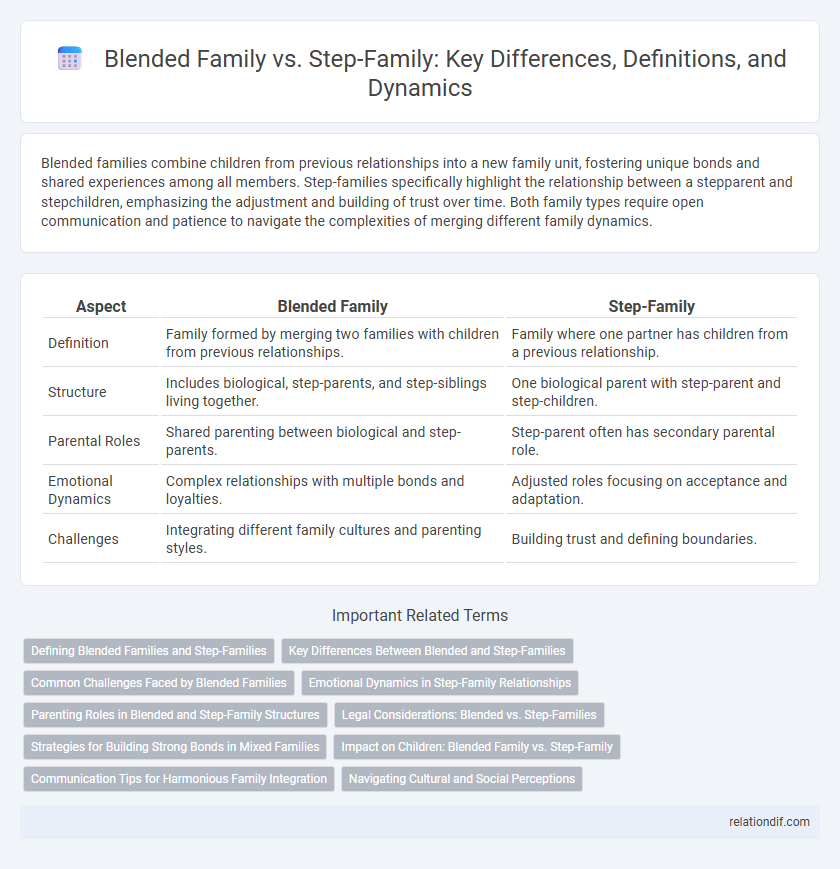Blended families combine children from previous relationships into a new family unit, fostering unique bonds and shared experiences among all members. Step-families specifically highlight the relationship between a stepparent and stepchildren, emphasizing the adjustment and building of trust over time. Both family types require open communication and patience to navigate the complexities of merging different family dynamics.
Table of Comparison
| Aspect | Blended Family | Step-Family |
|---|---|---|
| Definition | Family formed by merging two families with children from previous relationships. | Family where one partner has children from a previous relationship. |
| Structure | Includes biological, step-parents, and step-siblings living together. | One biological parent with step-parent and step-children. |
| Parental Roles | Shared parenting between biological and step-parents. | Step-parent often has secondary parental role. |
| Emotional Dynamics | Complex relationships with multiple bonds and loyalties. | Adjusted roles focusing on acceptance and adaptation. |
| Challenges | Integrating different family cultures and parenting styles. | Building trust and defining boundaries. |
Defining Blended Families and Step-Families
Blended families consist of partners with children from previous relationships who live together and share parenting responsibilities, creating a new family unit. Step-families specifically describe the relationships formed when one partner becomes a stepparent to the other's children, emphasizing legal or social parent-child roles. Both structures highlight the integration of members from different biological backgrounds into a cohesive household.
Key Differences Between Blended and Step-Families
Blended families consist of partners bringing children from previous relationships into a new family unit, often including biological children together, whereas step-families specifically refer to one partner having children and the other assuming a stepparent role. The dynamics in blended families involve navigating relationships among all children and parents, creating a fully integrated family structure, while step-families typically emphasize the relationship between stepparent and stepchild. Emotional bonds, co-parenting responsibilities, and legal considerations also vary, with blended families often facing more complex adjustments due to multiple parental roles and sibling relationships.
Common Challenges Faced by Blended Families
Blended families often encounter challenges such as navigating complex relationships between stepparents and stepchildren, establishing consistent parenting roles, and managing conflicting family traditions. Communication barriers and loyalty conflicts can increase emotional stress for all members involved. Financial strain and balancing time between biological and step-siblings further complicate the dynamics in blended family units.
Emotional Dynamics in Step-Family Relationships
Emotional dynamics in step-family relationships often involve complex challenges due to the integration of different family cultures and established bonds. Step-parents may struggle to build trust and authority while children adjust to new parental roles, impacting emotional stability. Navigating loyalty conflicts and fostering open communication are critical for promoting harmony and emotional well-being in step-families.
Parenting Roles in Blended and Step-Family Structures
Parenting roles in blended families involve navigating relationships with biological and non-biological children, requiring flexibility and clear communication to establish authority and emotional bonds. Step-family structures often face challenges in defining parental responsibilities, as stepparents balance respect for the biological parent's role while fostering trust and discipline with stepchildren. Effective co-parenting in both blended and step-family environments depends on mutual support, consistency, and negotiation of boundaries to promote a stable, nurturing household.
Legal Considerations: Blended vs. Step-Families
Legal considerations for blended families often involve navigating complex custody arrangements and inheritance rights, as these families include children from previous relationships alongside new partnerships. Step-families may face challenges establishing parental rights, as step-parents generally do not have automatic legal guardianship without formal adoption or court approval. Understanding state-specific laws regarding child support, visitation, and decision-making authority is crucial to protect the interests of all family members.
Strategies for Building Strong Bonds in Mixed Families
Blended families and step-families benefit from clear communication, shared activities, and mutual respect to foster strong bonds. Prioritizing individual relationships while creating new family traditions helps overcome challenges unique to mixed households. Establishing consistent routines and open dialogue promotes trust and emotional connection among all family members.
Impact on Children: Blended Family vs. Step-Family
Children in blended families often experience a complex adjustment period as they navigate relationships with both biological and stepparents, which can influence their emotional well-being and social development. Step-families, where one parent brings children into a new partnership, may face unique challenges related to loyalty conflicts and establishing new family roles, impacting children's sense of stability. Research indicates that positive communication and supportive co-parenting in both family types significantly reduce stress and promote healthy child development.
Communication Tips for Harmonious Family Integration
Effective communication in blended families involves establishing clear expectations and fostering open dialogue to address the unique challenges of merging different family dynamics. Step-families benefit from consistent family meetings that allow all members to express feelings, build trust, and resolve conflicts collaboratively. Prioritizing active listening and empathy promotes emotional bonds and smooth integration, enhancing overall family harmony.
Navigating Cultural and Social Perceptions
Navigating cultural and social perceptions in blended families involves understanding diverse traditions and expectations from both biological and non-biological members. Step-family dynamics often face unique challenges related to identity, acceptance, and societal stereotypes that impact family cohesion. Effective communication and cultural sensitivity are essential for fostering mutual respect and integrating different family values seamlessly.
Blended family vs Step-family Infographic

 relationdif.com
relationdif.com